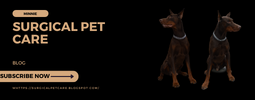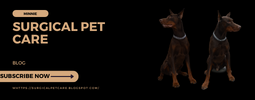After your dog undergoes surgery, it's important to understand the recovery process to help them heal and get back to their happy selves.
In this article, we'll cover everything you need to know about pet surgery recovery.
Introduction:
Pets are important members of our families, and we want nothing but the best for them. However, there may come a time when your furry friend requires surgery to treat a condition or injury.
While pet surgery can be scary and stressful for both you and your pet, it's important to understand that a successful surgery is just the beginning.
The recovery process is equally important in ensuring your pet's well-being and long-term health.
In this article, we'll walk you through the road to pet surgery recovery.
From what to expect during the first few days after surgery to how to help your pet heal and recover, we'll cover everything you need to know to make the process as smooth and stress-free as possible.
What to Expect During the First Few Days After Surgery
The first few days after surgery are crucial for your pet's recovery.
During this time, it's important to closely monitor your pet's behaviour and follow the post-surgery instructions provided by your vet.
Here's what you can expect during the first few days after surgery:
- Your pet may feel groggy and disoriented due to the effects of anesthesia.
- They may experience pain or discomfort, which can be managed with medication prescribed by your vet.
- Your pet may have a decreased appetite and thirst. Offer them small, frequent meals and make sure they have access to fresh water at all times.
- Your pet may require extra rest and sleep during this time.
How to Help Your Pet Heal and Recover
There are several things you can do to help your pet heal and recover after surgery.
These include:
- Following the post-surgery instructions provided by your vet, such as administering medication, keeping the incision site clean and dry, and limiting your pet's physical activity.
- Providing your pet with a comfortable and quiet space to rest and recover.
- Offering your pet plenty of love and attention to help them feel comfortable and reassured.
- Monitoring your pet's incision site for any signs of infection or complications, such as redness, swelling, discharge, or excessive licking.
Possible Complications
While most pets recover without any complications, there are some risks associated with surgery. It's important to be aware of these risks and to contact your vet if you notice any signs of complications.
Possible complications include:
- Infection at the incision site
- Excessive bleeding
- Allergic reactions to medication or anesthesia
- Adverse reactions to pain medication
If your pet has undergone surgery, it's essential to take all the necessary steps to ensure a smooth and comfortable recovery.
One way to help your pet during this process is by using a surgical pet shirt.
These specialized shirts have a range of benefits that can help improve your pet's recovery and make the process easier for both you and your furry friend. Here are some of the main benefits of using a
surgical pet shirt.
- Prevents Licking and Chewing: One of the main benefits of a surgical pet shirt is that it can prevent your pet from licking or chewing at their surgical site. This can help reduce the risk of infection and ensure that the incision heals properly.
- Reduces Stress: Surgery and the recovery process can be stressful for your pet. Wearing a surgical pet shirt can provide a sense of comfort and security, reducing stress and anxiety.
- Provides Compression: Some surgical pet shirts provide gentle compression, which can help reduce swelling and inflammation. This can be particularly beneficial for pets who have undergone abdominal surgery.
- Protects Wounds: A surgical pet shirt can also provide an extra layer of protection for your pet's surgical site. This can help prevent accidental bumps or scratches, which can cause pain or damage to the incision.
- Easy to Use: Surgical pet shirts are designed to be easy to use and put on your pet. They come in a range of sizes to fit different pets and are machine washable for easy cleaning.
- step by step guide to using your Surgical pet shirt
Overall, using a surgical pet shirt can provide a range of benefits for your pet during the recovery process.
By preventing licking and chewing, reducing stress, providing compression, protecting wounds, and being easy to use, these shirts can help your pet heal and recover more quickly and comfortably.
If your pet has undergone surgery, it's essential to take all the necessary steps to ensure a smooth and comfortable recovery.
One way to help your pet during this process is by using a surgical pet shirt.
These specialized shirts have a range of benefits that can help improve your pet's recovery and make the process easier for both you and your furry friend. Here are some of the main benefits of using a
surgical pet shirt.
- Prevents Licking and Chewing: One of the main benefits of a surgical pet shirt is that it can prevent your pet from licking or chewing at their surgical site. This can help reduce the risk of infection and ensure that the incision heals properly.
- Reduces Stress: Surgery and the recovery process can be stressful for your pet. Wearing a surgical pet shirt can provide a sense of comfort and security, reducing stress and anxiety.
- Provides Compression: Some surgical pet shirts provide gentle compression, which can help reduce swelling and inflammation. This can be particularly beneficial for pets who have undergone abdominal surgery.
- Protects Wounds: A surgical pet shirt can also provide an extra layer of protection for your pet's surgical site. This can help prevent accidental bumps or scratches, which can cause pain or damage to the incision.
- Easy to Use: Surgical pet shirts are designed to be easy to use and put on your pet. They come in a range of sizes to fit different pets and are machine washable for easy cleaning.
- step by step guide to using your Surgical pet shirt
Overall, using a surgical pet shirt can provide a range of benefits for your pet during the recovery process.
By preventing licking and chewing, reducing stress, providing compression, protecting wounds, and being easy to use, these shirts can help your pet heal and recover more quickly and comfortably.
FAQs
Q: How long does it take for a pet to recover after surgery?
A: The recovery time depends on the type of surgery and the pet's overall health. Some pets may recover in a few days, while others may require several weeks to fully heal.
Q: Can I bathe my pet after surgery?
A: It's important to follow the post-surgery instructions provided by your vet, which may include avoiding baths or water activities for a certain period of time.
Q: How can I tell if my pet is in pain after surgery?
A: Signs of pain may include restlessness, panting, whining, or reluctance to move or eat. Contact your vet if you suspect your pet is in pain.
Conclusion
Pet surgery can be stressful, but with the right care and attention, your pet can make a full and speedy recovery.
By following the post-surgery instructions provided by your vet, providing a comfortable and quiet space for your pet to rest, and monitoring their behaviour for any signs of complications, you can help your pet heal and recover safely and comfortably.
Remember, every pet is different, and recovery time can vary depending on the type of surgery and your pet's individual health needs. Be patient and provide plenty of love and support for your furry friend during this time.
If you have any concerns or questions about your pet's recovery, don't hesitate to contact your vet. They can provide guidance and support to ensure that your pet recovers as quickly and smoothly as possible.
In conclusion, pet surgery recovery can be a challenging process, but with the right care and attention, your pet can make a full recovery and get back to their happy, healthy selves.
By following the advice and tips provided in this article, you can help your pet heal and recover safely and comfortably, and ensure that they continue to bring joy and happiness to your life for years to come.




0 Comments